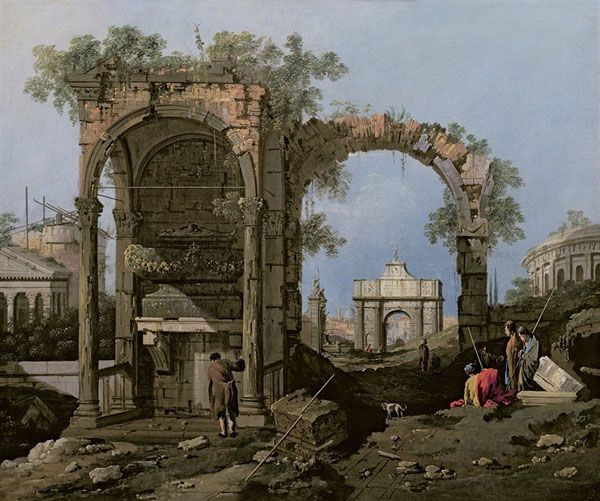49. Capriccio with Ruins and Classical Buildings, 1746.
Oil on canvas, 62 x 74 cm.
Galleria dell’Accademia, Venice.
His Return to Venice
Upon returning to his native city, he marvelled at the splendour of its sky, the unusual look of its canals and the picturesque quality of the palaces as if he were seeing them for the first time. From that moment on, the Venetian Republic would be his favourite model. Once in Venice he called upon Luca Carlevaris and Marco Ricci, both highly regarded by their contemporaries for their landscapes and their paintings of perspective. Their works often appeared together, such as in the home of a particularly wealthy Venetian, Girolamo Molin. Those by Marco were accompanied by pictures painted by his uncle, Sebastiano Ricco. However, Canaletto’s ever-increasing fame quickly surpassed theirs and, in the words of Dante, they were soon “chased from their nest”.
Canaletto’s path was clearly revealed to him as a result of his time in Rome. He returned to the magnificent, marmoreal waterway of the Grand Canal with an awareness of all he could glean from the artistic splendour of his grand Venice, the most flamboyant and colourful city of all. It always seemed new and captivating, like a lover whose attractions, because of her constantly seductive appearance, were never-ending. From this time on, he never again thought about producing ephemeral settings for those illustrious theatres where they would have rivalled Gozzi and Goldoni. It was no longer his mission to paint, like Pannini, the monumental vestiges of ancient architecture. He felt completely Venetian. The enchanting Venice lived peacefully and coquettishly under the gaze of the lover who was filled with wonder before such an incomparable model. His talent would from that time on be devoted to the languid beauty of the indolent, indulgent ever fresh dowager city, which had been thought of as the Queen Mother of the Adriatic and the East, imperious to the point of despotism. He lived completely in, through and for her. He became immortal by marrying every one of her faces, by adoring her in her great diversity. It was through her that he felt he could achieve glory, by celebrating her as best he could, solely based on his relentless work in portraying her.
